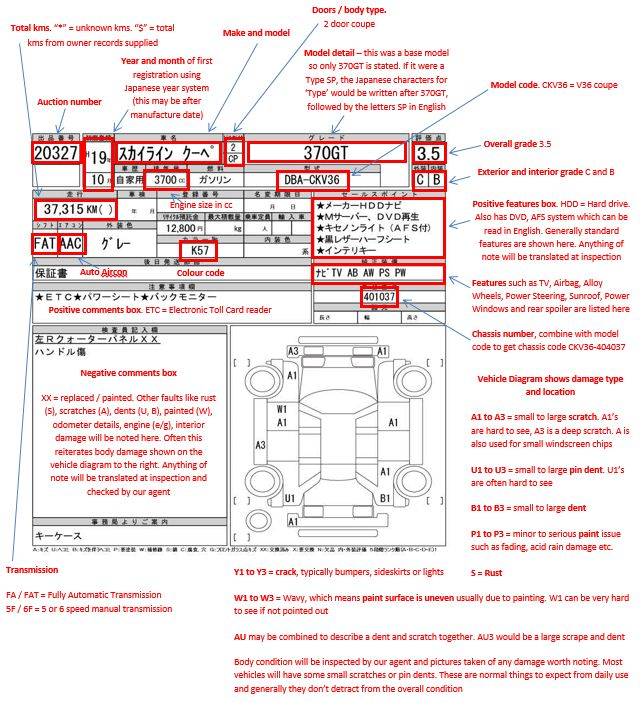What Is Our Auction Sheet Verification Service And How To Read It?

The Auction Sheet Verification Service is a detailed inspection and assessment of used vehicles based on their auction sheets. It entails a careful assessment of the car’s history, condition, and paperwork to give prospective purchasers comprehensive information before they decide to buy. Trained experts carefully examine the auction sheet during this service, looking for information on the overall grade, exterior and interior condition, mechanical state, service history, accident reports, and mileage verification, among other things. In order to support consumers in making educated decisions and reducing the risks involved in buying used cars, it is important to maintain accuracy and transparency when reporting the vehicle’s condition. This particular service is especially beneficial for purchasers who are unable to examine the car in person or who need further confirmation regarding its dependability and quality.
What is Auction Sheet?
The auction sheet provides a thorough and comprehensive assessment of the vehicle’s physical state. It represents the car’s condition at the time of bidding and is provided by the auction house. Any damage sustained during the journey is not noted in the sale sheet once the car departs the Japanese auction house and arrives in Pakistan. For this reason, some people bemoan the fact that their car has a dent or a blemish that isn’t noted in the auction sheet.
The body’s damage is probably the result of improper handling at the nearby ports, where it must wait for weeks to be cleared by customs officers. To ensure you are aware of the automobile’s true state as soon as it reaches Pakistan, Auction Sheet provides a car inspection service.
How to verify the Auction Sheet?
An auction sheet must be verified in multiple phases to guarantee its dependability and accuracy. This is how an auction sheet can be verified:
Check the Auction House:
Check the legitimacy and reputation of the auction house listed on the auction sheet. This can aid in confirming the accuracy of the data offered.
Verify the Vehicle Identification Number (VIN):
Verify if the vehicle’s VIN matches the one on the auction document. To make sure the auction document belongs to the right car, make sure they match.
Review the Overall Grade:
Vehicles with this grade have moderate mileage, some minor defects, and are generally in good shape. Despite being well-maintained in general, these cars may have minor dents, scratches, or wear commensurate with their age and use. They offer a decent trade-off between price and quality and are dependable.
Verify Mileage:
Verify that the mileage indicated on the auction sheet and the mileage shown on the car’s odometer correspond. Any disparities ought to be looked into more thoroughly.
Inspect Exterior and Interior Descriptions:
Compare the vehicle’s true condition with the descriptions of its exterior and inside. Keep an eye out for any wear or damage not noted on the auction sheet.
Grade 3:
Vehicles with a rating of 3 have severe wear and higher mileage, making them less than average in condition. These cars may need significant exterior and/or interior repairs due to their frequent noticeable flaws. They typically exhibit noticeable ageing and use symptoms because they are older and have been used more frequently.
Review Service History and Accident Records:
Look for any references to prior accidents or service history on the auction sheet. Check this information against the vehicle’s maintenance history and by looking for evidence of previous repairs.
These methods can help you ensure that an auction document is accurate and help you make a more informed choice when buying a used car.
How to read an Auction Sheet?
Reading an auction sheet requires comprehending the many parts and codes used to characterise a vehicle’s condition and history. Below is a tutorial on interpreting an auction sheet:
Overall Grade:
Usually, the auction sheet begins with an overall grade, represented by a letter such as S, A, B, etc., or by a number between 6 (excellent) and 1 (poor). Better condition is indicated by a higher rating.
The descriptions of the Outside and Inside:
Seek out details regarding the vehicle’s external and interior conditions. These could include information about any dings, dents, or other exterior damage, along with specifics about the state of the dashboard, interior upholstery, and other parts.
Mechanical Condition:
Find out about the mechanical systems of the car, including any known problems or recent repairs. Information regarding the engine, gearbox, suspension, brakes, and other components may be included in this section.
Service History:
Examine all documentation pertaining to the vehicle’s maintenance and repairs, taking note of the dates and miles. This may provide you some idea of how well the car has been cared for throughout time.
Accident History:
Seek information regarding any past collisions or damage to the car, including the degree of the harm and any repair records. You can evaluate the vehicle’s history and likelihood of future problems with this section
Mileage:
Check the mileage indicated on the vehicle’s odometer with the mileage listed on the auction sheet. Any disparities ought to be looked into more thoroughly.
Additional Notes:
Any additional remarks or notes on the auction page should be carefully read as they can include crucial details regarding the history or condition of the car.
You can read an auction sheet more efficiently and choose a used car with greater knowledge if you are aware of these sections and codes.
A Few Pointers to Keep in Mind When Interpreting an Auction Sheet

Final Words:
Our Auction Sheet Verification Service provides a key layer of security to used vehicle buyers. This service assists purchasers in making confident, well-informed selections by offering comprehensive and reliable information about a car’s condition, history, and specifications. Focusing on important details like overall grade, exterior and interior condition, mechanical status, service history, accident history, and mileage is necessary to comprehend and read auction sheets. This all-encompassing strategy guarantees openness and reduces the dangers involved in buying second-hand cars, thereby enabling a more seamless and dependable purchasing process.
